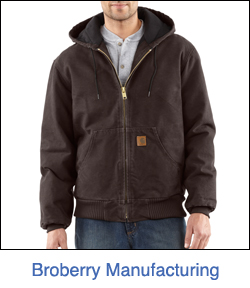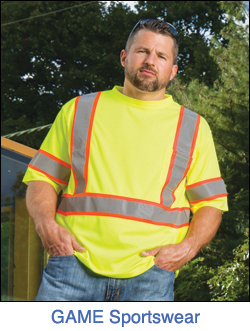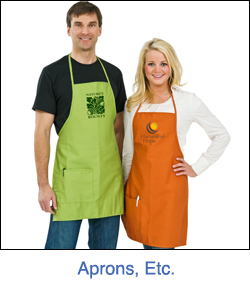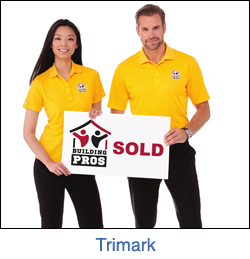Uniforms are certainly not all, well, uniform. Going about your typical day, you encounter a wide variety of workwear and uniforms – from the gas station attendants, to the restaurant servers, to the cable and plumbing guys, to road crews and even cashiers at big box retailers and supermarkets.
In other words, there are tremendous opportunities to delve into uniform sales.

 According to Erin J. Tricker of Broberry Manufacturing, uniforms are worn for many reasons in today’s society. “They provide the tool for all workers and workplaces to appear ‘uniform’ and professional. They allow workers the opportunity to not soil and ruin their own garments. They are a benefit to both workers and employers.”
According to Erin J. Tricker of Broberry Manufacturing, uniforms are worn for many reasons in today’s society. “They provide the tool for all workers and workplaces to appear ‘uniform’ and professional. They allow workers the opportunity to not soil and ruin their own garments. They are a benefit to both workers and employers.”
Broberry, says Tricker, offers a wide variety of uniforms from outdoor workwear, to flame-resistant, to scrubs. Garments range from dress pants, shorts, woven shirts, T-shirts and more. “Our garments are most suitable for employees in the gas industry, forestry, utility, engineering, general construction and sub contractors like electrical, plumbing, HVAC, framing, masonry, roofing; agriculture, outdoor recreation, manufacturing, warehouse, sports, government, law enforcement, airlines, freight transportation, even NASA and deep sea exploration. We are also the first in the industry offering Wrangler Riggs Workwear, Wrangler Pro Gear and Wrangler Rugged Wear, as well as Propper Tactical and FR gear,” she says.
Nino Phimphachanh of Expert Brand says that uniforms are worn to positively represent a company and brand, as well as to show unification among employees. “By providing employees with a uniform, they will feel more connected to the company that they work for, and if worn outside of the office or place of business, it can also be used in a promotional context,” he says.
Expert Brand, he adds, offers a variety of different uniform garments. For example, he points out, polo shirts are popular in the hospitality industry, performance T-shirts are popular for businesses that are engaged in health and fitness, and quarter zips are ideal for those in areas where the weather may get chilly at times or when an extra layer is needed to protect from the elements.

 Taraynn Lloyd of Edwards Garment believes uniforms are worn for a variety of reasons that include: safety – a high-visibility vest makes a visual statement letting drivers know to slow down for road construction crews; identification – security in red blazers at an arena lets the patrons know that people are there to protect and assist; and brand-building – hotels use color and style to have their associates extend the brand via what they wear.
Taraynn Lloyd of Edwards Garment believes uniforms are worn for a variety of reasons that include: safety – a high-visibility vest makes a visual statement letting drivers know to slow down for road construction crews; identification – security in red blazers at an arena lets the patrons know that people are there to protect and assist; and brand-building – hotels use color and style to have their associates extend the brand via what they wear.
According to Lloyd, Edwards garments are worn by employees in major industries including sports arenas, theme parks, retail chains, healthcare, bus and transit systems, corporations, airlines, hotels, restaurants, convention centers and casinos.
There are two other aspects of uniforms that Fred Haws of Haws USA says is strong and often quite overlooked by PPDs – reward programs. “For example, take a trucking company whose drivers log a certain number of miles with no accidents. For those safety rewards, why not utilize a premium brand such as Carhartt with the company logo and ‘XXX miles of safe driving.’ These can be given to those employees when they reach the milestone or at an annual company event.”
The other aspect is co-branding, Haws says, which is often overlooked. For example, electrical, plumbing, automotive repair businesses may get co-op funds from the vendor brands they use most prominently; the workwear can feature both the business logo and the vendor brand logo. These businesses will often receive some amount of co-op funds from the vendors to use in this or other promotional manners.

 “At Haws USA, we focus on both reward programs and co-op programs,” he comments. Haws offers two workwear garments as prime examples – styles J162 and J001. Style# J162 is a waterproof breathable jacket and is made of durable nylon with a special water-repellent finish. Its breathable membrane allows body heat to leave the garment even as it keeps rain and moisture out. The interior body lining is a 100 percent polyester mesh, with the sleeves and hood lined in nylon. The contoured three-piece hood features an adjustable draw cord and is removable. The hem is finished with an elastic drawcord to keep out wind and cold.
“At Haws USA, we focus on both reward programs and co-op programs,” he comments. Haws offers two workwear garments as prime examples – styles J162 and J001. Style# J162 is a waterproof breathable jacket and is made of durable nylon with a special water-repellent finish. Its breathable membrane allows body heat to leave the garment even as it keeps rain and moisture out. The interior body lining is a 100 percent polyester mesh, with the sleeves and hood lined in nylon. The contoured three-piece hood features an adjustable draw cord and is removable. The hem is finished with an elastic drawcord to keep out wind and cold.
Style# J001 is “a standard legacy jacket,” Haws describes. Made in the USA, this duck Detroit jacket is constructed of rugged 12-ounce, 100 percent cotton duck, and features a blanket lining in the body and quilted nylon lining in the sleeves. There’s a corduroy top collar with under-collar snaps to attach an optional hood. Inside, there’s a welt pocket and outside there are two large front pockets and a zippered left-chest pocket. The waist and cuffs are snap adjustable, and the bi-swing back makes for easier movement.
Unlike garments for casual wear, end-users have different desires when seeking uniforms. Says Lloyd, the buyers responsible for implementing a uniform program wants their associates to not only look good, but feel good about wearing the uniform, as well as will the garment wash and wear well for two years. Once those goals have been met, then they need to consider what type of decoration works best for their uniform programs – embroidery, heat transfers, emblems and even badges all have their place in a uniform program.

 “At Edwards we recommend embroidery because it works well with most all garments including suit coats,” she says. “However, we recognize that a great looking T-shirt with heat transfer logo can get the job done too. It really depends on budget and what the end-user buyer would like to achieve.”
“At Edwards we recommend embroidery because it works well with most all garments including suit coats,” she says. “However, we recognize that a great looking T-shirt with heat transfer logo can get the job done too. It really depends on budget and what the end-user buyer would like to achieve.”
For more industrialized workwear, says Haws, buyers need to have the most appropriate features that will work in the particular environment in which their employees will be working. For example, a hooded jacket may present a safety issue if a hood can easily get caught in machinery. Another example would be Velcro closure over buttons that may scratch a product; or metal buttons or zippers that can cause a spark.
“End-users are looking for comfort-driven performance apparel that can be used as a uniform, especially in the context of an outdoor environment where performance attributes are seen as more valuable – permanent moisture wicking, antimicrobial and easy-care properties,” observes Phimphachanh.
Uniforms, as you can discern, are anything but static!
CASE STUDIES
Taraynn Lloyd of Edwards Garment: A decorator distributor who was new to Edwards wanted to present a new pant concept to a school system client. Staff wearing these pants were primarily female team members working in the cafeteria. The pant needed to be comfortable, breathable, easy to home launder and stylish. The challenge was to create a stylish pant that provided all day comfort with an easy care fabric. The solution was to select a chino pant with an easy fit waistband to meet the all day comfort and easy care requirements. The easy-fit hidden waistband provides two inches of adjustment and the fabric has soil-release and moisture-wicking properties, which were very important to the client. In order to make the pant more fashion forward the Edwards eCustom team modified the pant to a Capri. Samples were drop shipped to the client for try-on and approval. Well they loved them and the Edwards distributor placed the order and within two weeks the client received the garments. The Edwards distributor was pleased with the outcome because the client was extremely happy with the new garments and this opened up a new revenue stream for the distributor, who had never sold pants or a modified garment before.
Nino Phimphachanh of Expert Brand: A fitness club was required to outfit its entire staff’s uniforms. After presenting a variety of options, the gym selected the following: trainers wore our Women’s Endurance Racerback (AI227) and Men’s Endurance Singlet (AI827) tanks, while administrative staff and managers wore our Women’s Angel Wings (AI232) and Men’s Freefall Colorblock (AI832) T-shirts. The whole gym looked very coordinated in the same color scheme (Safety Blue/White) and complemented each other very well, as it was very important to present themselves as a unified team. Our tanks offer a relaxed fit and have roomy armholes that reduce chafing, which is perfect for trainers who work out with their clients. They have an increased freedom of movement, inherent moisture wicking to keep dry and comfortable, and are treated with BodyFreshé to inhibit the growth of odor-causing bacteria. The support staff and management opted for performance apparel with short sleeves, in order to distinguish themselves from the trainers, but still look coordinated as a whole team.